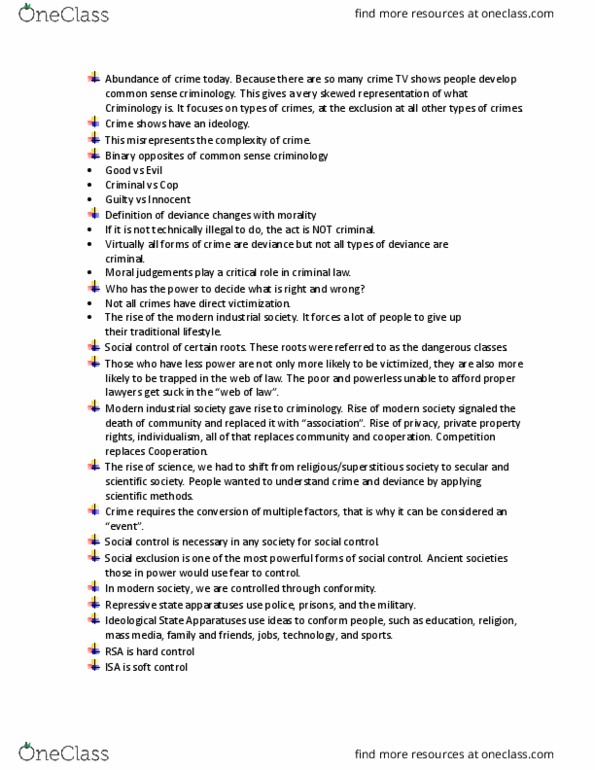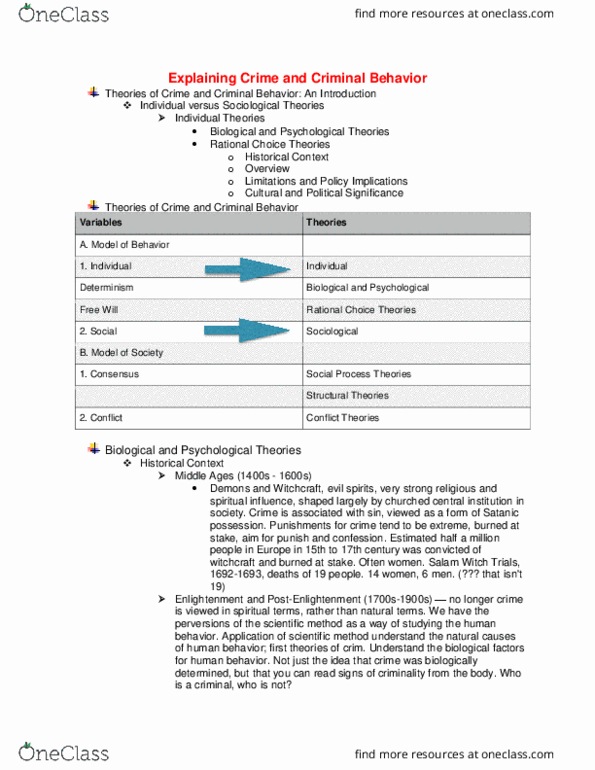CRIM 1650 Lecture Notes - Lecture 3: Scientific Method, Determinism, Psychopathy
Document Summary
Get access


Related Documents
Related Questions
There are sometimes conflicts within the same code, between the code and the __________ and between the code and a counselor's value system.
|
Judgment |
||
|
Ethics |
||
|
Law |
||
|
Value |
2 points
Question 2
Section A of the ACA Code of Ethics highlights important issues within the __________________________________.
|
Privacy Act |
||
|
Confidentiality Act |
||
|
Professional's Responsibility |
||
|
Counseling relationship |
2 points
Question 3
______________________ in a code sometimes lag behind the values of society and of professional associations.
|
Laws |
||
|
Attitudes |
||
|
Values |
||
|
Beliefs |
2 points
Question 4
Which section was added to the latest edition of the ACA Code of Ethics (2014)?
|
Resolving Ethical Issues |
||
|
Advocacy and Social Justice |
||
|
Distance Counseling, Technology, and Social Media |
||
|
Research and Publication |
2 points
Question 5
Which of the following is not one of the ethical "hot spots" identified in this chapter?
|
Gatekeeping |
||
|
Social and Cultural Issues |
||
|
Informed Consent |
||
|
Technology |
2 points
Question 6
Which of the following is not a type of ethical decision-making model discussed in the text?
|
Problem-solving model |
||
|
Advocacy model |
||
|
Social constructivist model |
||
|
Developmental model |
2 points
Question 7
_______________ has to do with protecting the independences, self-determination and freedom of choice for client.
|
Nonmaleficence |
||
|
Beneficence |
||
|
Justice |
||
|
Autonomy |
2 points
Question 8
People who have this view of the world, see things in black and white, are very concrete, rigid, and authoritarian.
|
Dualistic |
||
|
Modern |
||
|
Post-modern |
||
|
Flexible |
2 points
Question 9
Which section of the ACA Ethical Code (2014) offers guidelines on how to report an ethical violation?
|
Section B |
||
|
Section I |
||
|
Section E |
||
|
Section A |
2 points
Question 10
.__________ is the responsibility under the law for a violation of federal or state criminal statute.
|
Beneficence |
||
|
Nonmaleficence |
||
|
Civil liability |
||
|
Criminal liability |
2 points
Question 11
To prove that they are following the best practices of their professions, counselors should:
|
Know relevant laws |
||
|
Maintain good records |
||
|
Stay professional with clients |
||
|
All of the above. |
2 points
Question 12
______________ is the most rigorous form of credentialing.
|
Accreditation |
||
|
Licensure |
||
|
Certification |
||
|
Registration |
2 points
Question 13
Theories help counselors and other helping professionals in the following way(s):
|
conceptualizing clients' problems |
||
|
necessary to become a licensed psychotherapist |
||
|
offer specific techniques to apply |
||
|
both a and c |
2 points
Question 14
What is a paradigm shift?
|
A change like a universe. |
||
|
A change in the way information is perceived. |
||
|
A change in theory. |
||
|
A change in human nature. |
2 points
Question 15
Do psychodynamic theories consider which of the following to be important in understanding a person's functioning?
|
Child-rearing practices |
||
|
The unconscious and conscious |
||
|
Examining the past |
||
|
All of the above |
2 points
Question 16
Sigmund Freud was trained as a:
|
Physician |
||
|
Counselor |
||
|
Caseworker |
||
|
Social worker |
2 points
Question 17
Freud believed that there are ____________ structures that make up personality.
|
1 |
||
|
2 |
||
|
3 |
||
|
4 |
2 points
Question 18
Freud, and later his daughter Anna Freud, identified a number of _______________ that help people to cope with anxiety.
|
Defense skills |
||
|
Coping mechanisms |
||
|
Coping skills |
||
|
Defense mechanisms |
2 points
Question 19
___________ believed that each of us has a unique psychological type which includes the attitudes of extraversion and introversion.
|
Freud |
||
|
Rogers |
||
|
Jung |
||
|
Cattell |
2 points
Question 20
_______________________ believed that every child was born with innate and unique capabilities and is inherently moving toard the future, not determined by the past.
|
Adler |
||
|
Freud |
||
|
Rogers |
||
|
Jung |
2 points
Question 21
Existential-humanistic approaches embrace a phenomenological perspective, stressing all but which of the following?
|
The subjective reality of the client |
||
|
the role of the unconscious |
||
|
How the counselor uses his or her personal qualities in counseling |
||
|
the importance of consciousness and/or awareness |
2 points
Question 22
Although Ludwig Binswanger is generally acknowledged as being the first existential therapist, who is seen as the person who popularized this approach through "logotherapy"?
|
Irvin Yalom |
||
|
Carl Rogers |
||
|
Alfred Adler |
||
|
Viktor Frankl |
2 points
Question 23
____________________ developed client-centered therapy.
|
Carl Jung |
||
|
Viktor Frankl |
||
|
Carl Rogers |
||
|
Ludwig Binswanger |
2 points
Question 24
Today, most Gestalt therapists believe that from birth, the individual is in a constant state of ______________ through a process of need identification and need-fulfillment.
|
Self-regulation |
||
|
Self-actualization |
||
|
Existential crisis |
||
|
Emotional distress |
2 points
Question 25
This therapy was developed by Albert Ellis during the 1950s.
|
Psychodynamic therapy |
||
|
Behavioral therapy |
||
|
Cognitive therapy |
||
|
Rational emotive therapy |


